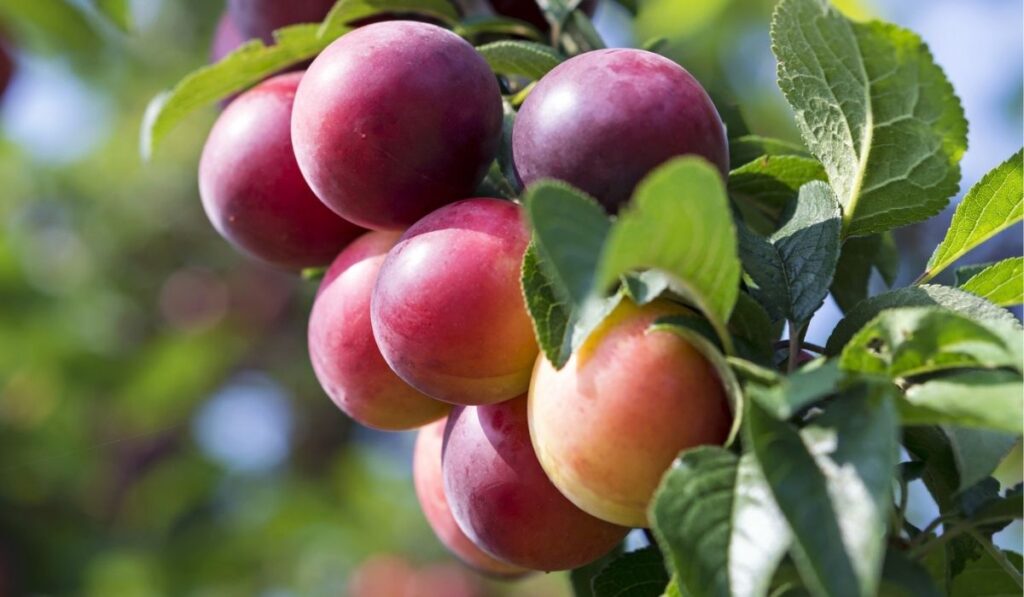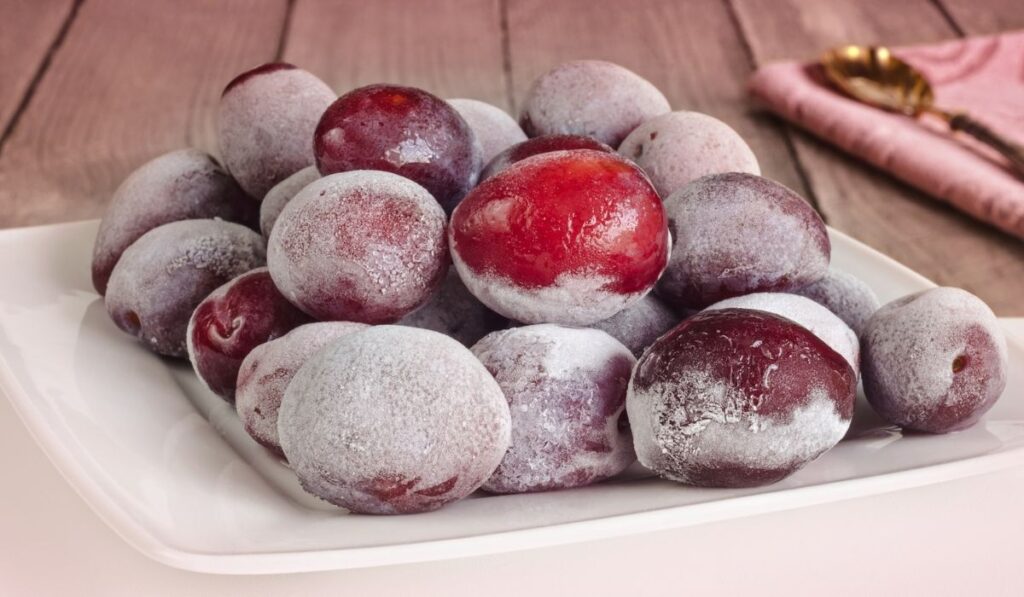The plum is a delicious stone fruit that belongs to the Prunus genus of plants. This fruit is native to China and has been cultivated there for over 2,000 years! Plums come in many different varieties, each with its own unique flavor and color. The most common type of plum is the European plum, which is what you’ll find in most supermarkets.
Plums typically ripen from late summer to early fall. When choosing plums, look for fruits that are firm and free of blemishes. Avoid plums that are soft or have bruises. If you’re not going to consume the plums right away, store them in a cool, dry place for a few days or freeze them for later use.
Plums aren’t just a tasty treat; they’re a great source of vitamins and minerals, including vitamin C, potassium, and fiber. Let’s take a closer look at which varieties you can find, where to buy them, and how to store them.
What Are the Varieties of Plums?

There are two main types of plums: European plums and Japanese plums.
European Plums
European plums are the most common type of plum. They have an oval shape, thick skin, high sugar content, and dense flesh. They’re primarily grown to be dried and are best for making jam and baking.
A paltry 3% of European plums are eaten fresh. Their skin color ranges from pale yellow to deep purple, and their flesh is usually yellow but can also be green or brown. There are different varieties of the European plum, some of the most common include:
- The cot (or greengage) plum has a greenish-yellow skin and is small in size. The uniqueness of this plum is its distinctive sweet flavor, which makes it a top choice for eating fresh and for use in desserts.
- The damson plum is slightly tart and mainly used for cooking. It has deep blue skin and is small in size.
- The Italian prune plum is named for its prune-like appearance. It’s small and dark purple with a sweet flavor. Italian prune plums are commonly used in baking.
- The Victoria plum is the most popular type of European plum. It has reddish-purple skin and yellow flesh. Victoria plums are named after Queen Victoria of England and were bred in the 19th century.
Japanese Plums
Japanese plums are also called Chinese plums and have a round shape. They’re smaller than European plums and have thinner skin. Japanese plums are juicier and less sweet than their European counterparts.
Most Japanese plums are consumed fresh, with only 10% used for cooking. Some of the most common varieties of Japanese plum include:
- The Beiwei plum is large and has greenish-yellow skin. It’s a popular choice for eating fresh and makes a good jam.
- The Kosui plum is small and yellow with a sweet flavor. It’s often used in Japanese cooking.
- The Satsuma plum is reddish-orange and is considered the best type of Japanese plum for eating fresh.
- The Shiro plum is white or pale yellow and has a sweet flavor. It’s often used in jams and desserts.
When Are Plums in Season?
Plum season typically runs from late May to September. However, the exact time will depend on the type of plum and your location. Japanese varieties ripen first, while European varieties ripen later. California has the longest plum season, with plums available from May to late September.
Michigan’s plum season typically runs from late July to early September. The region grows more European plums, but you can find some Japanese varieties as well.
There are no ripe plums during the winter in the US, so they’re imported from South America, particularly Chile. And, of course, don’t forget there are also dried plums (example on Amazon) available year-round.
What Are Pluots, Plumcots, And Apriums?
Pluots, plumcots, and apriums are all hybrids of plums. They are made by crossing the plum and the apricot. They are found in shades of green, purple and orange, and either represent the dominance of the parent species.
- Pluots are a blend of mostly plum with a bit of apricot. They have a strong apricot flavor and a somewhat firm texture. The Zaiger family trademarked the term “pluot” in the 1980s, so you’ll find pluot varieties with different names, such as Dapple Dandy, Geo Pride, or Flavor Supreme.
- Plumcots are 50/50 apricot and plum hybrids. They have a tart apricot flavor with a softer texture. The first plumcot was developed in the late 1800s, but the term “plumcot” wasn’t trademarked until the 1940s by Luther Burbank.
- Apriums are 75% apricot and 25% plum. They have a strong apricot flavor with a softer, plum-like texture. The term “aprium” was trademarked in the 1990s by Zaiger’s Fruit Tree Sales.
Where Should You Buy Plums?
If you want to find fresh plums, your best bet is to look at a farmer’s market. You can also find plums in the grocery store, but they may not be as fresh or ripe. Some sellers specialize in selling plums online.
This can be a good option if you want to buy in bulk or can’t find the plum variety you’re looking for locally.
You can find a diverse selection when plums are in season, but options are more limited during the winter. Some stores sell locally grown plums, and if you’ve got a store near you, then it’s best to befriend the seller so they can notify you when fresh plums are available.
How to Choose the Best Plum
When choosing a plum, you should look for one that’s ripe but not overripe. Ripe plums will be slightly soft to the touch and may give in slightly when you press on them. You should also avoid plums with bruises or blemishes. The skin should be smooth, with no wrinkles or brown spots.
The color of the plum will vary depending on the variety, but it should be uniform. If you’re buying plums online, make sure to check the seller’s shipping policy so you know how long the plums will take to arrive.
How to Store Plums
Plums typically last for three to five days. You can store them at room temperature or in the fridge. If you put them in the refrigerator, they will last longer, but they may lose some of their flavor.
To ripen plums, place them in a paper bag at room temperature for one to two days. You can also put them in a sunny spot for a day or two.
Once ripe, you should eat the plums within a few days. If you want to extend their shelf life, you can cook with them or make jam.
How to Freeze Plums

You can freeze plums whole, pitted, or sliced. To freeze whole plums, wash them and remove any blemishes. Then, place them on a baking sheet lined with parchment paper and put them in the freezer. Once frozen, transfer the plums to a freezer bag.
To freeze pitted or sliced plums, wash and prepare the fruit as desired. Then, place it on a baking sheet lined with parchment paper and put it in the freezer. Once frozen, transfer the plums to a freezer bag. Label the bag with the date and contents.
Frozen plums will last for up to six months.
How to Use Frozen Plums
Frozen plums can be used in jam, pies, and other baked goods. You can also add them to smoothies or yogurt. If you want to eat them whole, thaw the plums in the fridge overnight or at room temperature for a few hours. Once thawed, they will be softer and juicier than fresh plums.
Whether you’re using fresh or frozen plums, make sure to wash them thoroughly before eating or cooking with them.
